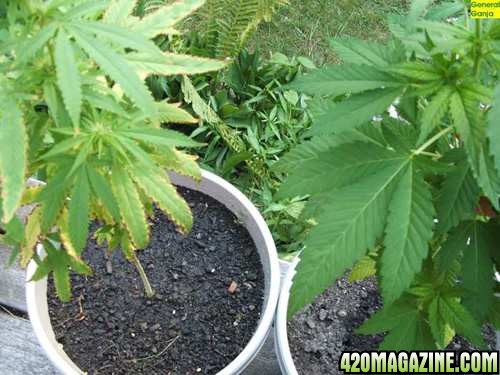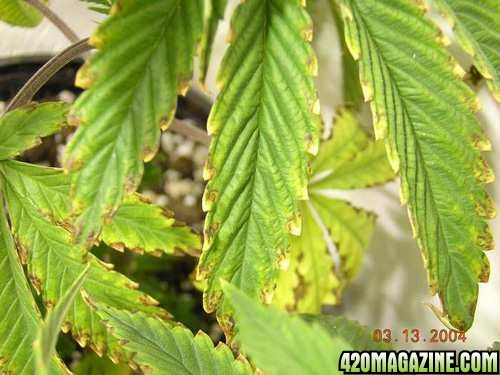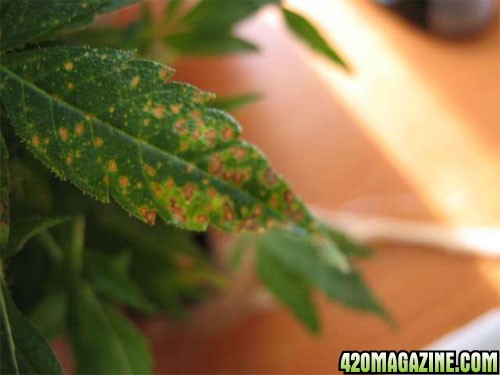johnny... what you using for nutes? I'd say one of a few poss problems... either nute lockout via ph ( check your soil or runoff from your soil)
or possibly a potassium / magnesium or even both deficiency...
Potassium: Leaves have a papery appearance; dead areas along the edges of leaves; growth is stunted...
Magnesium: Lower leaves turn yellow along the tips and margin and between the veins; the lower leaves wilt...
Potassium (K) Mobile Element and Macro Element
Potassium plays a big role as well. Having good amounts of potassium in your plants helps in having sturdy and thick stems, disease-resistance, water respiration, as well aids in photosynthesis. Potassium is also found in the whole plant. It is necessary for all activities having to do with water transportation. Potassium is necessary for all stages of growth, especially important in the development of Buds.
Having to little of Potassium in your plants causes the plants leaves to show retarded growth and show a scorched tip and edges around the leaves. Plants may stretch and your branches can be easily broken or weak. Don’t get this deficiency confused with iron, because it almost acts like iron but to tell the difference in the two is: for potassium the tips of the leaves curl and the edges burn and die. Older leaves may show a red colour and leaves could curl upwards. Dead patches (Necrosis) can happen on the margins of larger fan leaves thus, the leaves will eventually die off and turn brown. The Older leaves will show different patches of colour (mottle) and turn yellow between the veins, following by whole leaves that turn dark yellow and die. The plants overall growth slows down, mostly when they are in vegetative stage. To little amount of potassium also slows the growth of buds during flowering stages. Dark edges will appear around the edges of the leaf when the deficiency is starting to happen. When your Relative humidity is low, you can almost bet your going to soon get a potassium deficiency from your plants perspiration.
Potassium can get poorly absorbed when having too much Calcium or ammonium nitrogen, and maybe cold weather. Having to much sodium (Na) causes potassium to be displaced. SO keep those in mind… Parts affected by a Potassium Deficiency are: older leaves and leaf margins.
When you have too much Potassium in your soil, it can lead to big troubles, like salt damage and acid fixation of the root system, as well as too much potassium can cause a calcium deficiency. Your fan leaves will show like a light to a dark yellow to whitish colour in between the veins. Due to a molecular imbalance, potassium toxicity can cause a reduced uptake and lead to the deficiencies of Mg, and in some cases, Ca. Also leads to the other nutrients to not be absorbed properly leading to lots of other deficiency such as: magnesium, manganese, zinc and iron and can cause problems with calcium as well.
Problems with Potassium being locked out by PH troubles
Soils with excessive Leeching and High ph soils and or water.Soils that are potassium fixated. An excess of kitchen salts (sodium) in the root system/environment.
Soil
Potassium gets locked out of soil growing at ph levels of 4.0-5.5
Potassium is absorbed best in soil at a ph level of 6.0-9.5. (Wouldn’t recommend having a ph of over 7.0 in soil) anything out of the ranges listed will contribute to a Potassium deficiency.
Hydro and Soil less Mediums
Potassium gets locked out of Hydro and Soil less Mediums at ph levels of 4.0-4.5, 6.0-6.5.
Potassium is absorbed best in Hydro and Soil less Mediums at ph levels of 4.7-5.3, 6.7-8.5. (Wouldn’t recommend having a ph over 6.5 in hydro and soil less mediums.) Best range for hydro and soil less mediums is 5.0 to 6.0. Anything out of the ranges listed will contribute to a potassium deficiency.
Solution to fixing a Potassium deficiency
Any Chemical/Organic nutrients that have potassium in them will fix a potassium deficiency. Again Peters All Purpose plant food 20-20-20, will cure the potassium deficiency , Miracle grow Tomato plant food, Miracle grow All purpose plant food.( Only mixing at ½ strength when using chemical nutrients, or it will cause nutrient burn!) Some other supplements of potassium are: Wood ashes, which are fast absorption, Kelp Meal, which is medium absorption, Greensand, which is slow absorption, granite dust, which is slow absorption. Sulfate of Potash, Sulfate of Potash Magnesia, Muriate of Potash, which are medium absorption. FOXFARM GROW BIG HYDROPONIC CONCENTRATE, which is fast absorption. (

GB can bring your ph down as well) Earth Juice Meta-K, which is fast acting. (Can bring down your ph as well) Leaves will never recover, but the plant will show recovery after about 4 to 5 days when using a fast acting nutrient.
Note: Wood Ashes, can make your ph go up a bit, so please monitor your ph when using it.
Now if you added to much chemical nutrients and or organics, (which is hard to burn your plants when using organics) you need to flush the soil with plain water. You need to use 2 times as much water as the size of the pot, for example: If you have a 5 gallon pot and need to flush it, you need to use 10 gallons of water to rinse out the soil good enough to get rid of excessive nutrients.
Picture 1 and 2 shows a Potassium deficiency
Magnesium (Mg) - Micronutrient and Mobile Element
Magnesium helps supports healthy veins while keeping a healthy leaf production and its structure. Magnesium is significant for chlorophyll-production and enzyme break downs. Magnesium which must be present in relatively large quantities for the plant to survive, but yet not to much to where it will cause the plant to show a toxicity.
Magnesium is one of the easiest deficiencies to tell… the green veins along with the yellowness of the entire surrounding leave is a dead giveaway, but sometimes that’s not always the case here. In case you have one of those where it doesn’t show the green veins, sometimes leaf tips and edges may discolour and curl upward. The growing tips can turn lime green when the deficiency progresses to the top of the plant. The edges will feel like dry and crispy and usually affects the lower leaves in younger plants, then will affect the middle to upper half when it gets older, but It can also happen on older leaves as well. The deficiency will start at the tip then will take over the entire outer left and right sides of the leaves. The inner part will be yellow and or brownish in colour, followed by leaves falling without withering. The tips can also twist and turn as well as curving upwards as if you curl your tongues.
Excessive levels of magnesium in your plants will exhibit a buildup of toxic salts that will kill the leaves and lock out other nutrients like Calcium (Ca). Mg can get locked out by having too much Calcium, Chlorine or ammonium in your soil/water.
One of the worst problems a person can have is a magnesium def caused by a ph lockout. By giving it more magnesium to cure the problem when you are thinking you are doing good, but actually you are doing more harm then good. When the plants can’t take in a nutrient because of the ph being off for that element, the plant will not absorb it but it will be in the soil… therefore causing a buildup. A buildup will be noticed by the outer parts of the plant becoming whitish and or a yellowish color. The tips and part way in on the inner leaves will die and feel like glass. Parts affected by Magnesium deficiency are: space between the veins (Interveinal) of older leaves; may begin around interior perimeter of leaf.
Problems with Magnesium being locked out by PH troubles
Light Acid Soils, soils with excessive potassium, calcium and or phosphorus
Soil
Magnesium gets locked out of soil growing at ph levels of 2.0-6.4
Magnesium is absorbed best in soil at a ph level of 6.5-9.1 . (Wouldn’t recommend having a ph of over 7.0 in soil) anything out of the ranges listed will contribute to a Magnesium deficiency.
Hydro and Soil less Mediums
Magnesium gets locked out of Hydro and Soil less Mediums at ph levels of 2.0-5.7
Magnesium is absorbed best in Hydro and Soil less Mediums at ph levels of 5.8-9.1
(Wouldn’t recommend having a ph over 6.5 in hydro and soil less mediums.) Best range for hydro and soil less mediums is 5.0 to 6.0. Anything out of the ranges listed will contribute to a Magnesium deficiency.
Solution to fixing a Magnesium deficiency
Any Chemical/Organic nutrients that have Magnesium in them will fix a Magnesium deficiency. (Only mixing at ½ strength when using chemical nutrients or it will cause nutrient burn!)
Other nutrients that have magnesium in them are: Epsom salts, which is fast absorption. Dolomite lime and or garden lime (same thing just called different) which is slow absorption. Sulfate of Potash, Magnesia which is medium absorption. Worm Castings, which is slow absorption. Crabshell which is slow absorption. Earth Juice Mircoblast, which is fast acting. (a must buy!! Has lots of 2ndary nutrients).
Now if you added to much chemical nutrients and or organics,( which is hard to burn your plants when using organics) You need to Flush the soil with plain water. You need to use 2 times as much water as the size of the pot, for example: If you have a 5 gallon pot and need to flush it, you need to use 10 gallons of water to rinse out the soil good enough to get rid of excessive nutrients.
Picture one shows a mid grade magnesium deficiency.
(Pictures courtesy of -43)

 Calcium (Ca)
Calcium (Ca) -Macro Nutrient and an Immobile element.
Calcium is another important element that helps the plants cell walls, cell division in making the plants stems, stalks, branches stronger, as well as contributing to root growth, mostly the newer root hairs, Calcium also helps enhancing the uptake of K in the the plants roots. Calcium moves really slow within the plant and tends to concentrate in roots and older growth.
When plants exhibit a Calcium deficiency the younger leaves are the first to show it as well as older leaves. The Leaf tips will die back, the tips may curl, and growth of the plant is stunted. The plant can show a weakness in the stems and branches, as well as a under developed root system that can lead to bacteria problems with roots dieing off. Having slow plant transpiration rates can aggravate the uptake of calcium. Make sure your soil isn’t very acidic, for calcium gets harder to be absorbed through acidic soils, Which leads to having a plant that is deficient in Calcium. The leaf tips, edges and new growth will or may turn a yellow/brown colour that happen in spots and often surrounded by a sharp brown outlined edge and then the leaf tips die back. If too much calcium is given at an early stage of growth it can stunt the growth of your plants. Having to much of calcium will also flocculate when a concentrated form is combined with potassium. The parts affected by a calcium deficiency are the roots. Stem or petiole, young or old leaves.
Too much Calcium will lead to other micronutrient deficiencies. Calcium fixation is caused by many types of mediums such as: clay soils, unbuffered coco and humus. The lime tends to bond to these soils very easily. The stems of the plant will not be able to hold the plant up and will exhibit a white brown in between the veins of the leaves when having too much calcium. Also having to much potassium and or nitrogen will cause a calcium lockout.
Problems with Calcium being locked out by PH troubles
Very acidic soils with excessive potassium, dry and or wet soil. Lack of calcium in the soil may cause too acidic soil. This may cause to Mg or Iron deficiency or very slow stunted growth
Soil
Calcium gets locked out of soil growing at ph levels of 2.0- 6.4
Calcium is absorbed best in soil at a ph level of 6.5-9.1 (Wouldn’t recommend having a ph of over 7.0 in soil) anything out of the ranges listed will contribute to a
Calcium Deficiency.
Hydro and Soil less Mediums
Calcium gets locked out of Hydro and Soil less Mediums at ph levels of 2.0- 5.3
Calcium is absorbed best in Hydro and Soil less Mediums at ph levels of 5.4-5.8 (Wouldn’t recommend having a ph over 6.5 in hydro and soil less mediums.) Best range for hydro and soil less mediums is 5.0 to 6.0. Anything out of the ranges listed will contribute to a Calcium Deficiency.
Solution to fixing a Calcium deficiency
To fix a calcium deficiency you can treat by foliar feeding with one teaspoon of dolomite lime or Garden lime per quart of water, Or Any Chemical/Organic nutrients that have Calcium in them will fix a Calcium deficiency. (Only mixing at ½ strength when using chemical nutrients or it will cause nutrient burn!)
Or you can take crushed up dolomite lime or garden lime in a gallon of water and water it in the soil. 1 to 2 teaspoons per gallon of water, which will be slow acting. Garden Gypsum, which is medium absorption. Limestone, which is medium absorption, Rock Phosphate and Animal wastes which are both medium/slow absorption.
Note: Caution when using gypsum to an already acid soil (pH that is less than 5.5) can have a very bad effect on different types of plants by effecting the absorption of soil aluminum, which is poison to plant roots.
Now if you added to much chemical nutrients and or organics, (which is hard to burn your plants when using organics) you need to flush the soil with plain water. You need to use 2 times as much water as the size of the pot, for example: If you have a 5 gallon pot and need to flush it, you need to use 10 gallons of water to rinse out the soil good enough to get rid of excessive nutrients.
Pictures 1-2 shows calcium deficiencies. First one shows late, 2nd one shows early development.
ref:
https://www.autoflower.org/f7/basic-deficiencies-list-11.html






 Little harsh but the curing will take care of that, Im picking up like 6 of those 62%RH humiditor packs to put in my jars, Do you still have to burb the jars with the packs in there??? Im very happy with it though, I'd say about 10% ambers. I put her in the dark, for how long?????? And whatever it is as far as hrs you guys say, I'll chop it and put some pics up......My guess is around 38 grams, shes pretty thick. The cab got 4 more 2 inch inlets making it 8 total now where there was only 4. Thats the dresser cab. It was like 84 degrees and like 20-24% RH, now its staying at 81F 36%RH, thats the digital one. The stick on the wall reptile thermo says the same temp but is saying its 41%RH . 12 cfls still throw off a bit of heat.
Little harsh but the curing will take care of that, Im picking up like 6 of those 62%RH humiditor packs to put in my jars, Do you still have to burb the jars with the packs in there??? Im very happy with it though, I'd say about 10% ambers. I put her in the dark, for how long?????? And whatever it is as far as hrs you guys say, I'll chop it and put some pics up......My guess is around 38 grams, shes pretty thick. The cab got 4 more 2 inch inlets making it 8 total now where there was only 4. Thats the dresser cab. It was like 84 degrees and like 20-24% RH, now its staying at 81F 36%RH, thats the digital one. The stick on the wall reptile thermo says the same temp but is saying its 41%RH . 12 cfls still throw off a bit of heat.